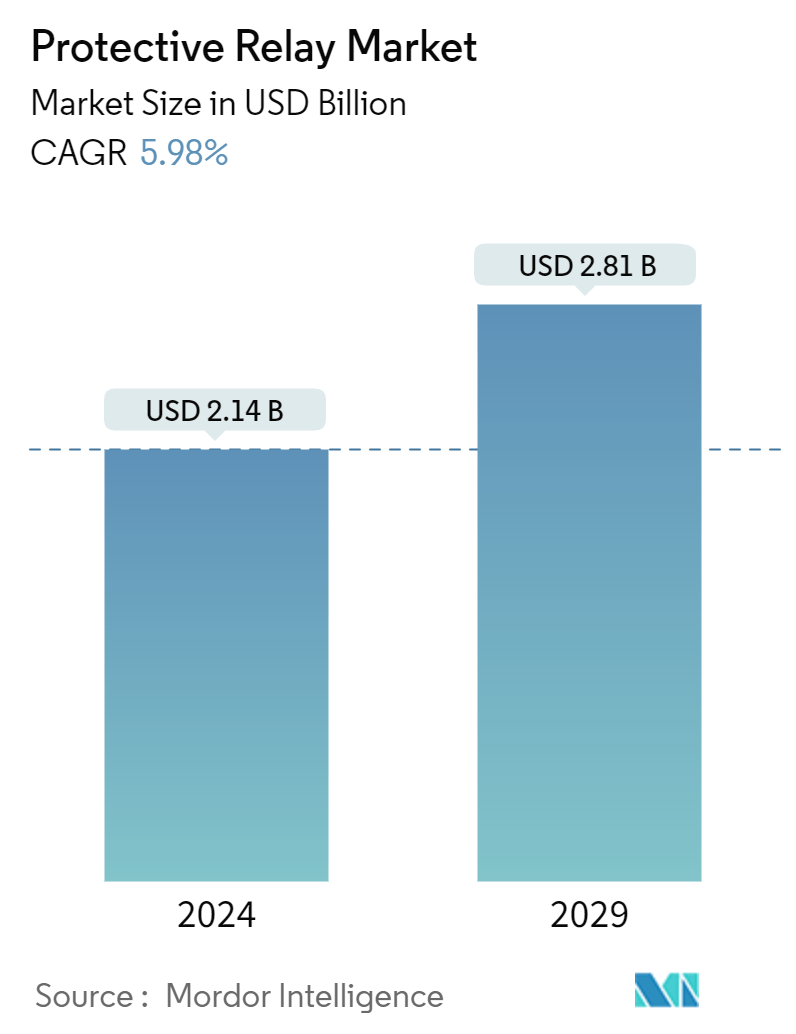Market Size of Protective Relay Industry

| Study Period | 2019 - 2029 |
| Market Size (2024) | USD 2.14 Billion |
| Market Size (2029) | USD 2.81 Billion |
| CAGR (2024 - 2029) | 5.98 % |
| Fastest Growing Market | Asia Pacific |
| Largest Market | North America |
Major Players
*Disclaimer: Major Players sorted in no particular order |
Need a report that reflects how COVID-19 has impacted this market and its growth?
Protective Relay Market Analysis
The Protective Relay Market size is estimated at USD 2.14 billion in 2024, and is expected to reach USD 2.81 billion by 2029, growing at a CAGR of 5.98% during the forecast period (2024-2029).
A protective relay acts as a switchgear device to detect faults and guide the circuit breaker to separate the faulty element of an electrical system. Usually, these relays are compact and self-contained devices that detect abnormal conditions within the electrical circuits by constantly measuring the electrical quantities dissimilar in normal and fault conditions.
Protection relays can be either electronic/microprocessor-based or electromechanical. While electronic or microprocessor relays use digital technology to provide quick, accurate, reliable, and repeatable outputs, electromechanical relays consist of mechanical parts that require routine calibration to stay within intended tolerances.
Protective relays are widely used in electricity generation and distribution applications. Hence, the growing demand for electricity is anticipated to remain among the major factors driving the market's growth. For instance, according to the International Energy Agency (IEA), the global electricity demand is anticipated to witness a Y-o-Y change of 938 TWh in 2025, compared to 859 TWh in 2024.
The market for renewable energy has gained significant momentum in recent years. Several factors influence the influx of investments in the renewable energy sector, including the growing impact of global warming, which is forcing the government and other stakeholders to look for reasons and solutions to control environmental emissions. Furthermore, the fluctuating prices and limited availability of fossil fuel-based energy sources across different regions are also creating an ecosystem favorable to the growth of the renewable energy sector.
However, the higher installation cost of these relays is among the significant factors challenging the market's growth. The protection relays in the sizeable industrial setup often require additional circuitry, increasing the overall cost. They also require regular maintenance, which impacts these relays' operational costs. Furthermore, the growing competition from the unorganized sector also challenges the market's growth.
Macroeconomic factors play a crucial role in the market's growth, such as the general economic condition of the market or geopolitical issues, which significantly impact the major end-user industries of protective relays, including manufacturing, industrial, utility, etc.
The COVID-19 outbreak and lockdown restrictions worldwide affected industrial activities. Some of the major impacts of the pandemic include supply chain disruptions, lack of availability of raw materials used in manufacturing, labor shortages, fluctuating raw material prices, shipping problems, etc. Especially during the initial phase, the market became stagnant due to the shutdown of factories, causing a halt in various industries such as automobile and oil production. As a result, businesses operating across various sectors increased their investment in advanced technologies such as AI, IoT, and automation, which positively impacted the demand for data centers across the world.
